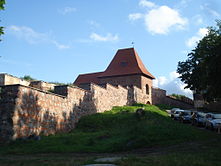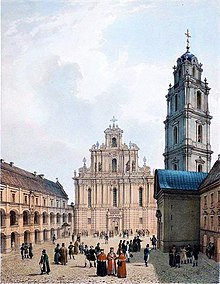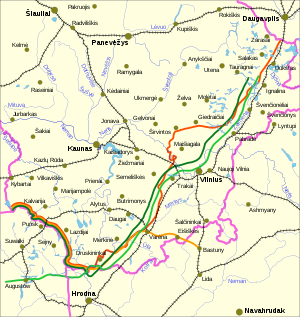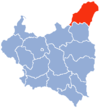History of Vilnius
This article has multiple issues. Please help improve it or discuss these issues on the talk page. (Learn how and when to remove these template messages)
|
| "Legend has it that the Grand Duke of Lithuania, represents a castle and a city which will be established by you on this site. This city will be the capital of the Lithuanian lands and the dwelling of their rulers, and the glory of their deeds shall echo throughout the world"
|
| The Legend of the Founding of Vilnius[1] |
The city of
Grand Duchy of Lithuania

The earliest settlements in the area of present-day Vilnius appear to be of
The city was first mentioned in written sources as Vilna in 1323 as the capital city of the Grand Duchy of Lithuania in the letters of Gediminas.[2] Gediminas built his wooden castle on a hill in the city. The city became more widely known after he wrote a circular letter of invitation to Germans and Jews to the principal Hansa towns in 1325, offering free access into his domains to men of every order and profession. Gediminas founded first Dominican monastery in 1321. In the second half of the century church of St. Nicholas was erected. At this time Vilnius was facing numerous raids of the Teutonic Order, although they never captured the castle, large portions of the town were burned down in years 1365, 1377 and 1383.
Vilnius was granted


According to a tale, tired after a busy hunting day,

English king Henry IV spent the full year of 1390 supporting the unsuccessful siege of Vilnius by
Between 1503 and 1522, for the sake of protection from
The gradual Polonization of Vilnius, which began in the late 14th century,[9] proceeded through the influx of Polish elements[citation needed] and assimilation of non-Polish burghers. The early Polish population was composed mainly of clerics, craftsmen and merchants, who migrated to the Lithuanian capital in particularly noticeable numbers after the Polish court of Sigismund August moved to Vilnius.[9]
Polish-Lithuanian Commonwealth

After the

Rapidly developing, the city was open to migrants from both East and West. In addition to old citizens, larger Jewish, Orthodox and German communities established themselves in the city. Each group made its contribution to the life of the city, and crafts, trade and science prospered. In the 17th century, Polish and Polonized population began to dominate culturally and likely numerically.[9]
In 1610, the city was racked by a large fire.[10] In 1655, during the First Northern War, Vilnius was captured by the forces of Tsardom of Russia and was pillaged, burned and the population was massacred. The death toll of around 20,000 included a large proportion of Vilnius Jews.[11] The city's growth lost its momentum for many years, yet the number of inhabitants recovered. During the Commonwealth's decline, Vilnius became known as "Jerusalem of the North" - a major religion-cultural centre of Eastern European Jewry.[12] In 1769, the Rasos Cemetery was founded; today it is one of the oldest surviving cemeteries in the city.
Russian Empire

After the

During the second half of the 19th and the beginning of the 20th century Vilnius also became one of the centres of Jewish, Polish, Lithuanian and Belarusian national rebirths. According to the 1897 Russian census, by mother tongue, 40% of the population was Jewish, 31% Polish, 20% Russian, 4.2% Belarusian and 2.1% Lithuanian.[17][18] Jewish culture and population was so dominant that some Jewish national revival leaders argued for a new Jewish state to be founded in the Vilnius region, with the city as its capital. These national revivals happened in Vilnius because it was one of the most tolerant, progressive and liberal places in the region, a legacy of tolerance deriving from the years of the Grand Duchy of Lithuania. One of the most important Polish, Belarusian poets and writers published their works in Vilnius at that time. It was the place where the first Belarusian weekly Nasha Niva was founded.[citation needed]
Vilnius became an important place of the act of the Lithuanian national revival on 4–5 December 1905, when the
Cultural life was revived after the
Interwar period
Polish-Lithuanian conflict


During
Finally, on 1 January 1919, the German garrison withdrew and passed the authority over the city to a local Polish committee, against the pleas of the Lithuanian administration.[

Shortly after the defeat in the Battle of Warsaw in 1920, the withdrawing Red Army handed the city over to Lithuania, following the Soviet–Lithuanian Peace Treaty of 12 July 1920.[26] The treaty allowed for the transfer to Lithuanian authority of some part of the areas of the former Grand Duchy of Lithuania. Although the city itself, as well as its surroundings, were actually transferred, the fast pace of the Polish offensive prevented additional territories to be handed over by the Red Army and the disputed area was split into Lithuanian and Polish-controlled parts.[citation needed]
Many historians argue[
As Russia ceased to be a major player in the area, Polish-Lithuanian relations worsened. In demographic terms Vilnius was one of the most Polonized and Russified[27][28] of Lithuanian cities during 1795-1914 Russian rule,[29] with Lithuanians constituting a mere fraction of the total population: 2% - 2,6% according to Russian (1897), German (1916) and Polish (1919) censuses. The latter two indicated that 50,1% or 56,2% of the inhabitants were Poles, while the Jewish share in the population amounted to 43,5% or 36,1%[30][31][32] (they were conducted after a large part of the inhabitants of Vilnius were evacuated to Russia,[33][34] mostly Voronezh[35] because of war in 1915). The Lithuanians nonetheless have a strong historical claim to the city (former capital of the Grand Duchy of Lithuania, the very centre of the formation of medieval Lithuanian state) and refused to recognize any Polish claims to the city and the surrounding area.[29] Lithuanian national activists, for example Mykolas Biržiška and Petras Klimas, supposed Poles and Belarusians in the Vilnius province to be "Slavicized Lithuanians" who, regardless of their individual preferences, must "return to the language of their blood".[36]
After the Bolshevik armies were pushed out of the area, the line reached by the Lithuanian forces before the Poles arrived was secured and diplomatic talks started. However, the negotiations on the future of the disputed area, held under the auspice of the
On 9 October 1920, the 1st Lithuanian–Belarusian Division under General Lucjan Żeligowski seized the city in a staged mutiny. Vilnius was declared the capital of Republic of Central Lithuania, with Żeligowski as its head of state.[26][37] The negotiations in Brussels continued, but the Polish move complexified the situation. Among the plans proposed by the Entente was a creation of a Polish-Lithuanian state based on a cantonal system, with shared control over the disputed area. While this was acceptable to both sides, Poland insisted on inviting the Central Lithuanian representatives to the talks. Simultaneously, the Lithuanian politicians argued that Central Lithuania was but a puppet state of Poland and rejected the idea. Finally, the talks came to yet another stalemate and no agreement was reached.
Elections in Central Lithuania
On 8 January 1922, general parliamentary elections were held in Central Lithuania. Apart from the Lithuanian, Jewish and Belarusian organisations that eventually decided to
Group of 32 Lithuanian activists, among them Mykolas Biržiška and Juozapas Kukta were deported to Lithuania on 6 February 1922, they were charged with espionage, what theoretically could be punished with death, but Polish officials just wanted to get rid of the most troublesome individuals, which anti-Polish activity was funded by the government in Kaunas.[43][44][45]
At the
The
Poland



Poles together with Jews, made up a majority in the city of Vilnius itself. In the years 1920–1939
In spite of the unfavorable geopolitical situation (which prevented the trade with the immediate neighbors of Lithuania, Germany and Soviet Russia, life in the town flourished.[
Vilnius was also an informal capital of
Situation of Lithuanian minority
According to Lithuanian historian Antanas Tyla the Polish administration in the Vilnius Region carried out policy of polonization and ethnocide of Lithuanians.[58] The situation of the Lithuanian minority worsened especially during the tenure of the Vilnius Voivode Ludwik Bociański, who, especially from 1936, introduced a policy of repression..[59] On 1936 February 11, a secret anti-Lithuanian memorandum called O posunięciach władz administracji ogólnej w stosunku do mniejszości litewskiej w Polsce oraz o zamierzeniach w tym wględzie na przyszłość (transl. About the actions of the general administration authorities in relation to the Lithuanian minority in Poland and about plans for the future in this regard) was issued by voivode Ludwik Bociański to the Polish administration, which stated the measures for suppressing the Lithuanian minority in Vilnius and the adjacent region, then under Polish control.[59][60] The execution of the secret anti-Lithuanian document, adopted by voivode Ludwik Bociański, resulted in closure of almost all Lithuanian schools, reading rooms, ban of Lithuanian organizations, while its members were imprisoned or deported.[61][62] As a result, at the beginning of the 1939/40 school year, Lithuanian education in Poland was limited to the only private primary school and a sole private secondary school, named after Vytautas the Great in Vilnius. In addition, in 102 state common schools with Polish as the language of instruction, Lithuanian language was virtually taught as a subject.[63]
World War II
Return to Lithuania

At the beginning of the
After talks in
A month of Soviet rule in Vilnius had catastrophic consequences: the city was starving, the museums and archives looted, the valuables, industry[70] and historic documents were stolen and transferred to Russia, and many people were imprisoned or deported. Apparently, the Lithuanian government was deliberately slowing down the transfer of the capital back to Vilnius due to fears that the Soviet military presence around the city would enable the Russians to overthrow the Lithuanian government if it were based there.



Annexation of Vilnius was greeted with rejoicing among Lithuanians, a whole generation was raised in the belief that Lithuania cannot be truly itself without the city of Vilnius – its capital, inscribed in
After the Lithuanian army entered the city, at the end of October 1939, the demoralized Polish local population started a four-day-long anti-Jewish pogrom, in which one person lost their life and some 200 were wounded.[73][74]), the Jewish community asked nearby Russian military units for intervention. The violence only stopped after a group of 35 Soviet tanks briefly re-entered the city and put an end to the pogrom.[75] This prevented further pogroms, that were expected on the 10th–11 November, a traditional day of anti-Jewish disturbances in the city.[67]
The Lithuanian authorities started a campaign of de-occupation and de-Polonization of the city, similar policies also targeted the Jews.[73] Immediately upon entering the city, the Lithuanian authorities abolished the use of Polish złoty (as occupied by the Germans and the Soviets Poland ceased to exist a month earlier and its currency crashed) and ordered the currency to be converted to Lithuanian litas, with only a 250% devaluation.[73] Soon other discriminatory[clarification needed] policies followed. During the several months-long period of retaking of Lithuanian capital, which from the Polish point of view was an unlawful occupation,[76] roughly 50,000 Lithuanians (mostly officials of state ministries and their family members) came to the capital city of Lithuanians.[77]
One of the decisions made by Lithuanian authorities in this period was reformation of the
Soviet occupation
The process of moving the capital was not yet finished when in June 1940, despite Lithuanian resistance,[ or deported to Siberia or Kazakhstan at that time.
German occupation
In June 1941 the city was again seized by Nazi Germany. In the old town centre, two
Soviet occupation

The Germans were forced to leave Vilnius in July 1944 by the combined pressure from the

The Soviets decided that Vilnius was to become again part of the
Vilnius suffered relatively little wartime damage, and most of its buildings survived the war unscathed. However, the decade after the war, both ghetto areas with the famous Great Synagogue and the northern part of German street, as well as the whole quarter on Pilies street, were torn down.[81]
By the end of the war, only 111.000 people were left in Vilnius, had a critical influence on the demographic situation of the city in the 1960s. Vilnius experienced a rapid population upsurge due to the inner migration of Lithuanians from the other parts of the country to the capital.
Independent Lithuania
Beginning in 1987 there were massive demonstrations against Soviet rule in the country.
On 23 August 1988, 150,000-200,000 people gathered in Vilnius.
The importance of Vilnius for Belarus remained at the end of the 20th century. In June 1989 Vilnius was the site of the Belarusian Popular Front conference as the Belorussian Soviet authorities would not allow the event to take place in Belarus. At the beginning of the 21st century, several institutes such as the European Humanities University and the independent sociology centre NISEPI were persecuted in Belarus by the government of Alexander Lukashenko have found an asylum in Vilnius.
In the years following its independence, Vilnius has been rapidly evolving and improving, transforming from a Soviet-dominated enclave into a modern European city in less than 15 years.
In July 11-12, 2023, a NATO summit was held in Vilnius.[86]
See also
- Timeline of Vilnius history
- History of Lithuania
- History of Poland
- Vilnius
- Ethnic history of the Vilnius region
- Lithuanian partisans
References
- ^ Vilnius legend Archived 11 December 2007 at the Wayback Machine
- ^ Rowell, Stephen Christopher (2003). Chartularium Lithuaniae res gestas magni ducis Gedeminne illustrans – Gedimino laiškai (PDF). Vilnius: Leidykla Vaga. Retrieved 7 June 2017.
- ^ Nowak, Markus. "Schmelztiegel der Kulturen - Die Ausstellung Vokiečių gatvė/Deutsche Straße in Vilnius". KK – Kulturkorrespondenz östliches Europa. 2022 (Mai/Juni): 31.
- ^ "Presentation of the earliest known depiction of the Lithuanian capital". Archives of Slovenia. Archived from the original on 16 February 2012. Retrieved 29 April 2012.
- ISSN 1408-0419. Archived from the originalon 18 July 2012.
- ISBN 9986-500-30-3.
- ISBN 83-85130-22-5.
- ISBN 83-7322-789-X.
- ^ a b c Jerzy Ochmański, "The National Idea in Lithuania from the 16th to the First Half of the 19th Century: The Problem of Cultural-Linguistic Differentiation", Harvard Ukrainian Studies, Vol. X. No. 3/4. 1986, pp. 310-311.
- ^ Władysław Czapliński, Władysław IV i jego czasy (Władysław IV and His Times). PW "Wiedza Poweszechna". Warszawa 1976, p. 23
- ^ Andres Kasekamp, A History of the Baltic States, Palgrave Macmillan, 2010, p. 67.
- ISBN 978-88-16-70153-3, p. 65.
- ^ Kasekamp, 2010, pp. 68-69
- ^ Piotr S. Wandycz, The lands of partitioned Poland, 1795–1918, University of Washington Press, 1974, p. 166.
- Central European University Press. 2008. pp. 70, 78, 80.
- ^ The First General Census of the Russian Empire of 1897, The city of Vilnius
- ^ Robert Blobaum, "Feliks Dzierzynski and the SDKPIL a study of the origins of Polish Communism", page 39: the multinational composition of the city - in which the Jewish inhabitants stood as the numerically largest group (40%), followed by the Poles ( 31%), Russians (20%), Belorussians (4.2%) and the Lithuanians (2.1%).
- ^ a b Olkowski 2017, p. 196
- ^ a b Michał Gałędek. Ustrój administracji ogólnej na Wileńszczyżnie w okresie międzywojennym (The Organization of the Administration in the Vilnius Land in the Interwar Period), Tabularium, 2012, pp. 47-48.
- ^ Jerzy Borzęcki, The Soviet-Polish Peace of 1921 and the Creation of Interwar Europe, Yale University Press, 2008. pp. 10-11.
- ^ Borzęcki, 2008, p. 14.
- ^ Borzęcki, 2008, p. 16.
- ^ ISBN 0-7126-0694-7.
- ^ Borzęcki, 2008, p. 83.
- ^ a b Kasekamp, 2010, p. 104.
- ^ Merkys, Vytautas (2006). Tautiniai santykiai Vilniaus vyskupijoje 1798-1918 m. Vilnius. p. 479.
{{cite book}}: CS1 maint: location missing publisher (link) - ^ Staliūnas, Darius (2002). Rusifikacijos samprata XIX a. Lietuvos istorijoje: istoriografija, metodologija, faktografija. Vilnius.
{{cite book}}: CS1 maint: location missing publisher (link) - ^ a b Michael MacQueen, The Context of Mass Destruction: Agents and Prerequisites of the Holocaust in Lithuania, Holocaust and Genocide Studies, Volume 12, Number 1, pp. 27–48, 1998, [1]
- ISBN 83-05-12769-9, pp. 11, 104
- ^ (in Russian) Demoscope Archived 27 September 2007 at the Wayback Machine
- ^ Michał Eustachy Brensztejn (1919). Spisy ludności m. Wilna za okupacji niemieckiej od. 1 listopada 1915 r. (in Polish). Biblioteka Delegacji Rad Polskich Litwy i Białej Rusi, Warsaw.
- ^ Vilniaus patuštinimas // Dabartis, nr. 4, 1915 m., p. 3.
- ^ Rusijos pabėgėlių vargai // Dabartis, nr. 4, 1915 m. p. 3.
- ^ Vida PUKIENĖ. Voronežas – lietuvių švietimo židinys Rusijoje Pirmojo pasaulinio karo metais; Istorija. Lietuvos aukštųjų mokyklų mokslo darbai. Vilnius: VPU,2008, t. 70, p. 17–27
- ^ According to the Lithuanian territorial program, formulated already in 1905, Lithuanian territory included the provinces of Kaunas, Suwałki, Wilno, and Grodno, as well as part of Courland. Lithuanian national activists viewed Polish and Belarusian inhabitants of these provinces as "Slavicized Lithuanians" who must "return to the language of their blood," and argued that individual preferences were, in this case, irrelevant. Borzęcki, 2008, pp. 35, 322 - Notes.
- ^ Jerzy J. Lerski. Historical Dictionary of Poland, 966–1945. 1996, p.309
- ^ a b Łossowski 1995, p. 119.
- ISBN 9955-584-87-4
- ^ A. Srebrakowski, Sejm Wileński 1922 roku. Idea i jej realizacja, Wrocław 1993
- ^ "A. Srebrakowski, Stosunek mniejszości narodowych Litwy Środkowej wobec wyborów do Sejmu Wileńskiego" (PDF). Archived from the original (PDF) on 16 July 2020. Retrieved 26 December 2020.
- ^ "A. Srebrakowski, Konflik polsko_litewski na tle wydarzeń roku 1920" (PDF). Archived from the original (PDF) on 30 September 2020. Retrieved 26 December 2020.
- ^ Čepėnas, Pranas (1986). Naujųjų laikų Lietuvos istorija. Chicago: Dr. Griniaus fondas. p. 656.
- ^ Januszewska-Jurkiewicz 2010, p. 210-211.
- ^ Mačiulis, Staliūnas 2015, p. 87.
- ISBN 978-83-01-04993-5.
- ISBN 9955-601-92-2.
- ^ Jan. T. Gross, Evolution from Abroad: The Soviet Conquest of Poland's Western Ukraine and Western Belorussia, Princeton University Press, 2002, p. 3.
- ^ Borzęcki, 2008, p. 252.
- ^ "Drugi Powszechny Spis Ludności z dnia 9 XII 1931 r". Statystyka Polski (in Polish). D (34). 1939.
- ^ Rasa Sperskienė "Advokatas Tadas Vrublevskis – lietuvių politinių bylų dalyvis"[permanent dead link]
- ^ Januszewska-Jurkiewicz, Joanna (2005). "Koncepcje programowe działaczy Obozu Zjednoczenia Narodowego Okręgu Wileńskiego i Nowogródzkiego w kwestii białoruskiej". Białoruskie Zeszyty Historyczne (in Polish). 23: 192–212.
- ^ Burauskaitė, Birutė. "Vilniaus krašto ir Vakarų Baltarusijos lenkų, baltarusių, lietuvių ir žydų bendruomenės istorijos verpetuose 1939–1944 m. Mitai ir stereotipai". Genocid.lt (in Lithuanian).
- ISBN 83-04-03675-4.
- ^ Edward Raczynski (1941). "5: The Economic Structure". Eastern Poland. London: Polish Research Centre in London.
- ^ "A. Srebrakowski, Targi północne w Wilnie 1928-1939" (PDF). Archived from the original (PDF) on 16 July 2020. Retrieved 26 December 2020.
- ^ "A. Srebrakowski, Uniwersytet Stefana Batorego w Wilnie 1919-1939" (PDF). Archived from the original (PDF) on 16 July 2020. Retrieved 26 December 2020.
- ^ Tyla, Antanas (6 October 2011). "Suvalkų sutartis ir jos išniekinimas". Alkas.lt (in Lithuanian).
- ^ a b Ereminas, Gintautas (2015). "Lenkijos valdžios politika lietuvių tautinės mažumos atžvilgiu (1935–1939 m.)". Gimtasai kraštas (in Lithuanian). 9: 6.
- ^ Ściśle tajny memorjał Wojewody Wileńskiego Bociańskiego z dnia 11 lutego 1936 r. O posunięciach władz administracji ogólnej w stosunku do mniejszości litewskiej w Polsce oraz o zamierzeniach w tym wględzie na przyszłość : dwa załączniki z d. 11 i 21 marca 1938 r.
- ^ Macukonienė, Janina (2022). "Nepamirškime skaudžių mūsų tautos istorijos faktų" (PDF). Aušra (in Lithuanian). 2 (843): 19–21.
- ^ Ereminas, Gintautas. "Lenkijos valdžios polonizacijos politika prieš lietuvių tautinę mažumą (1935–1939 m.)". Genocid.lt (in Lithuanian).
- ^ Miąso, Józefa, ed. (1980). Historia wychowania. Wiek XX (in Polish). Warsaw. pp. 131–132.
{{cite book}}: CS1 maint: location missing publisher (link) - ^ Это вам не 1939 год. Родина (in Russian). Москва: ООО «Родина МЕДИА». September 2006. Archived from the original on 4 September 2012.
- ^ Mačiulis & Staliūnas 2015, p. 173-174
- ^ Mačiulis & Staliūnas 2015, p. 175-176
- ^ a b Bauer p. 108
- ^ Levin, p. 44
- ^ Mačiulis & Staliūnas 2015, p. 180
- ^ The whole "Elektrit" factory was transferred to Minsk, together with all the qualified workers (Levin, p. 40)
- ^ Stankeras 2010, p. 224
- ^ Mačiulis & Staliūnas 2015, p. 181
- ^ ISBN 978-0253355201.
- ISBN 978-0-8143-1672-6.
- ^ Levin, p. 51
- ISBN 90-420-0850-4.
- ^ ISBN 0-7864-0371-3.
- ISBN 978-13-16-02561-1, p. 179.
- ^
- ^ Stravinskienė, Vitalija (2004). "Poles in Lithuania from the second half of 1944 until 1946: choosing between staying or emigrating to Poland (summary)". Lietuvos istorijos metraštis, 2004 vol 2. The Lithuanian institute of history. Archived from the original on 27 September 2007. Retrieved 13 February 2007.
- ^ KAROLIS KUČIAUSKAS / KARO PADARINIŲ VERTINIMAS VILNIAUS SENAMIESTYJE 1944 M.
- ISBN 978-99-86-52339-0, p. 81.
- ISBN 978-02-53-00631-8, p. 83.
- ^ Kasekamp, 2010, p. 163.
- ISBN 978-14-74-27522-4, p. 538.
- ^ "NATO In Retrospect". www.nato.int. 27 July 2023. Retrieved 15 September 2023.
Bibliography
- Borzecki, Jerzy (2008). The Soviet-Polish Peace of 1921 and the Creation of Interwar Europe. Yale University Press.
- Theodore R. Weeks, FROM “RUSSIAN” TO “POLISH”: Vilna-Wilno 1900–1925
- ISBN 978-83-8012-603-9.
- Kłos, Juliusz (1937). "Wilno", 3rd ed (in Polish). Wilno.
{{cite book}}: CS1 maint: location missing publisher (link) - (in Polish) Jerzy Remer, Wilno, Poznań
- ISBN 83-85660-59-3.
- Levin, Don (2005). Żydzi wschodnioeuropejscy podczas II wojny światowej (in Polish). Warszawa: IPN PAN. ISBN 83-7399-117-4.
- Olkowski, Roman (2017). "Walka o rewindykację tzw. dóbr kultury po II wojnie światowej". Muzealnictwo (in Polish). 58: 195–207. .
- ISBN 9986-830-47-8.
- Weeks, T. R. (2015). Vilnius between Nations, 1795–2000. Northern Illinois University Press.
External links
- Chronicles of the Vilna Ghetto: wartime photographs & documents – vilnaghetto.com
- History of Vilnius – brief history in timelines.
- Remains of Napoleon's army in Vilnius discovered
- A. Srebrakowski, The nationality panorama of Vilnius, Studia z Dziejów Rosji i Europy Środkowo-Wschodniej, Vol 55, No 3 (2020)
